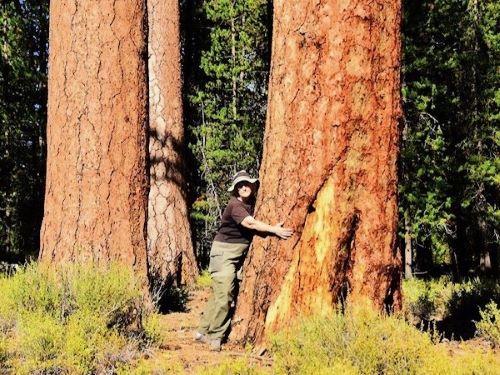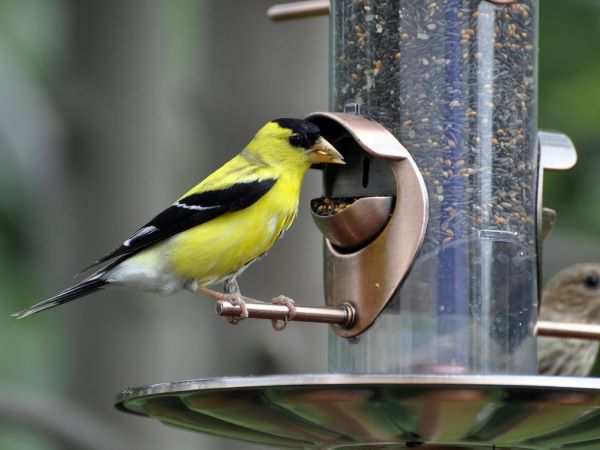Our Habitat Haven volunteers have begun site visits and been enthusiastically received. At the start…
Debbie Schlenoff
I’m always impressed by the skill with which many birders can identify bird species by ear. The birds can one-up us though; they can recognize individual birds by song. Several scientific studies have demonstrated that birds can discriminate between the songs sung by their neighbors and those sung by strangers. For birds, good relationships with neighbors may prove important. When blackbirds have familiar neighbors, they expend less energy to defend boundaries and have better reproductive success than birds that have to deal with strangers in the adjacent territory. In Great Tits, familiarity between long-term neighbors leads to cooperative behavior that increases nesting success. Birds, of course, do not recognize the territorial boundaries between neighboring human nations. Turns out that many of the birds we see in our backyards journey from our urban environment to the most extensive wilderness area left on earth, the boreal forest of our neighbor to the north.
Boreal forest spans Canada from the east coast of Newfoundland to the Yukon and separates the tundra on the north from the temperate rain forest and deciduous woodlands of southern Canada. The boreal region is dominated by coniferous forests interspersed with vast wetlands and provides habitat for over a billion nesting birds each summer—it is considered North America’s bird nursery. The area provides nesting habitat for about 325 species of birds. For example, 74% of all Common Loons breed within the boreal forest, as well as 93% of Red-necked Grebes, 48% of Double-crested Cormorants, 64% of American Widgeons, 84% of Black Scoters, 85% of White-winged Crossbills, 58% of Fox Sparrows, and 67% of White-crowned Sparrows.
Canada’s boreal forest provides ecosystem services on a global scale. It purifies air and water, slows the pace of climate change by storing carbon, and supports billions of migratory birds as well as populations of woodland caribou, lynx, wolverines, and bears. Boreal birds act as plant pollinators and pest controllers. They distribute seeds and redistribute nutrients. The birds are responsible for billions of dollars contributed to the economy of both Canada and the United States from tourism—traveling, hiking, bird-watching, and hunting. Significantly, the birds also act as environmental indicators for the health of the ecosystem. Many boreal species are in decline; populations of some boreal birds such as Olive-sided Flycatchers, Canada Warblers, and scoters have fallen by over two-thirds of their numbers. The area is threatened by large-scale industrial activities, including logging (over 4000 acres every day), mining, and oil and gas development. All of these activities further fragment and degrade habitat through the construction of extensive systems of roadways. Oil-sands activity has led to more than 66% of the 34 million acres in the Alberta boreal region being leased to companies for extraction.
A new report entitled “Boreal Birds Need Half: Maintaining North America’s Bird Nursery and Why It Matters” (see full citation below) was released this spring to address the threats to the boreal forest and its inhabitants. The report summarizes scientific studies that have shown that boreal birds require connected, large protected areas for their populations to be sustained. These birds do not nest in dense colonies; instead, they require broad, undisturbed habitat. The report concluded that for the health of the ecosystem and its bird inhabitants, a minimum of 50% of the boreal forest should be protected from industrial disturbance. Industrial activity in remaining areas should be well regulated to control degradation, especially of waterways. The report also emphasizes the important leadership role of the Aboriginal communities and governments in boreal forest conservation. A recent poll in Quebec found overwhelming support for the conservation of at least half the boreal forest and may be indicative of the opinions of many Canadians. Now we just need to get the rest of the neighbors on board.
Find the full report at: www.borealbirds.org/sites/default/files/pubs/birdsneedhalf_0.pdf.
Wells, J., D. Childs, F. Reid, K. Smith, M. Darveau, and V. Courtois. 2014. Boreal Birds Need Half: Maintaining North America’s Bird Nursery and Why It Matters. Boreal Songbird Initiative, Seattle, Washington, Ducks Unlimited Inc., Memphis, Tennessee, and Ducks Unlimited Canada, Stonewall, Manitoba.
What you can do:
Reduce your use of disposable paper products. Use products such as paper, tissues, and paper towels that have the highest amount of post-consumer recycled fibers. Look for the Forest Stewardship Council (FSC) logo on wood products. Think energy efficiency. Oppose tar-sands extraction, an inefficient and destructive method that emits large volumes of greenhouse gases and toxic sludge, wastes vast amounts of water, and destroys the boreal forest. A good article and photos of the tar sands are at: http://www.huffingtonpost.com/2014/05/29/photos-keystone_n_5404159.html?utm_hp_ref=green.



